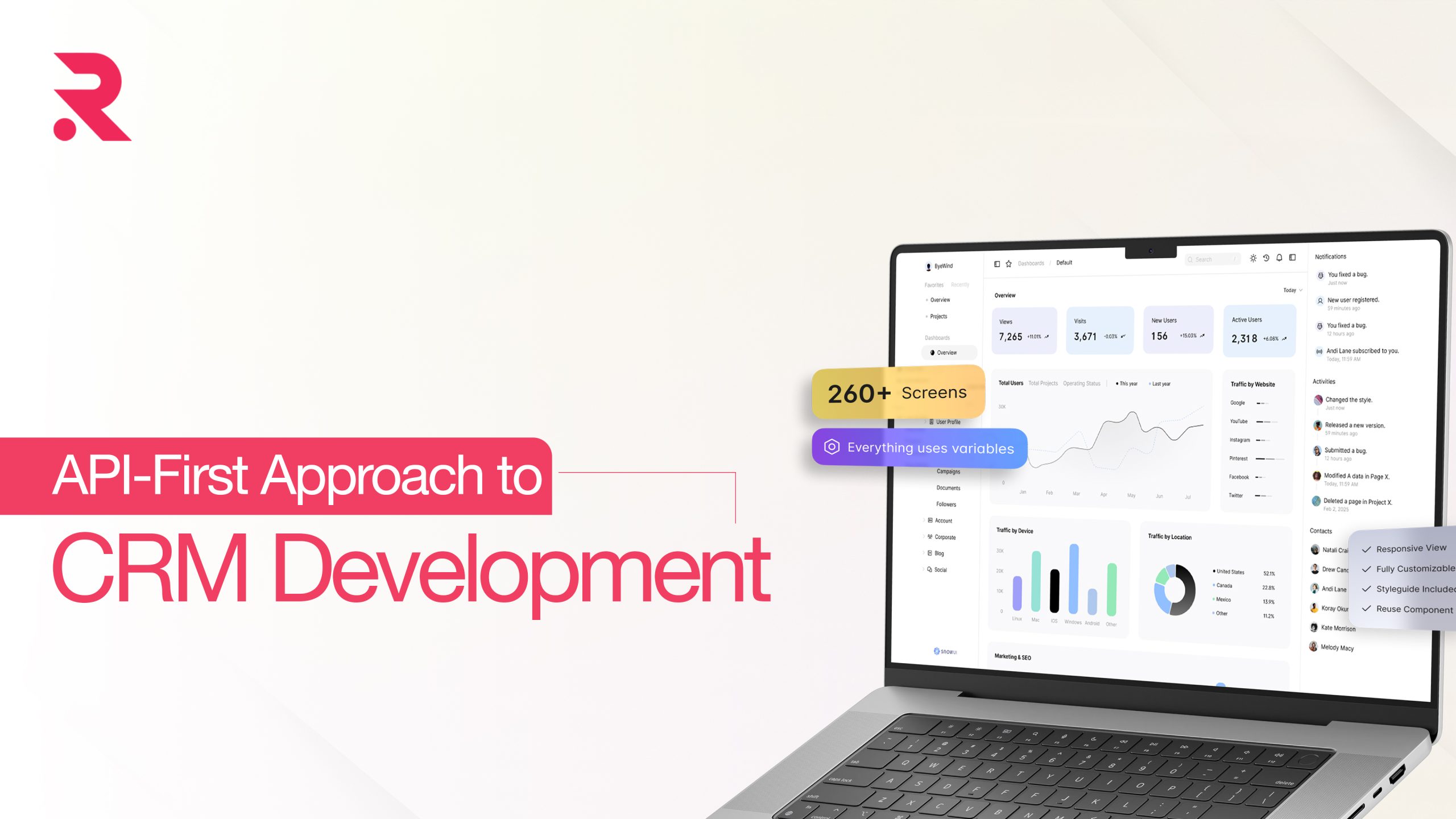What is website Analytics and its Benefits for Business Growth and Boosting Sales
- Apr 16, 2024
- By Tarun

Recent studies reveal that 64.5% of the world’s population, or roughly 5.19 billion people, now have access to digital communications. Therefore, to provide a pleasant and engaging customer experience for such a vast and diverse audience, it’s crucial to understand their mindsets and preferences.
But are you wondering how you can do that?
Using data analytics, companies can identify distinct customer types and tailor experiences based on their past choices and behaviors.
Are you wondering how? Let us walk you through it!
What exactly is website analytics?
Website analytics is the process of gathering, measuring, and analyzing data concerning the performance and usage of a website. Essentially, it’s about understanding how visitors interact with a website, from the moment they land on it to when they leave.
For example, let’s consider an online clothing store called “Fashion Haven.”
Fashion Haven wants to understand how users are engaging with their website to improve their overall online experience and boost sales. They can do that easily by using website analytics tools, such as Google Analytics, Hotjar, Mixpanel or Woopra.

Fashion Haven can track various metrics to gain valuable insights into user behavior such as:
- Traffic Source
- Page Views
- Bounce Rate
- Time Spent on Site
- Conversion Rate
- Customer interaction
Why Do Businesses Rely on Website Analytics Tools?
Businesses rely on website analytics tools to gain a deeper understanding of their online presence. These tools provide valuable insights into website traffic, user behavior, and conversion rates, which are essential for making informed decisions.
By analysing this data, businesses can optimise their websites, improve user experience, and ultimately boost sales and customer satisfaction.
Here are some more reasons why businesses rely on website analytics tools:
- Making Informed Decisions: Website analytics give businesses concrete data about how their site is performing, how users are behaving, and how effective their marketing efforts are. Instead of guessing, businesses can use real-time data to make smart decisions for more customer retention.
- Understanding Customer Behavior: These tools provide deep Customer insights into how people interact with a website. Businesses can see which pages are most visited, how long users stay, and where they tend to drop off. This helps them understand what customers want and adjust their strategies accordingly for more customer engagement
- Enhancing User Experience: Analytics reveal areas where the user experience can be improved. By looking at things like bounce rates, page load times, and how users navigate the site, businesses can make improvements. This might mean redesigning the layout, making navigation easier, or speeding up the site to make users happier.
- Measuring ROI: These tools help businesses track the return on investment (ROI) of their online activities. Businesses can see which efforts are paying off by monitoring metrics like conversion rates and revenue. This information helps them prioritise future investments and use their resources more effectively.
- Gaining a Competitive Edge: Staying ahead in a competitive market is crucial. Website analytics provide insights into market trends, customer preferences, and what competitors are doing. By using these insights, businesses can find opportunities for growth and innovation, keeping them ahead of the curve.
Are you having trouble tracking your customer behaviour using website analytics tools? Don’t worry! Get in touch with the top-notch Ecommerce agency today.
The 5 step process for analyzing customer data with customer Data analytics
Imagine you’re a detective solving a mystery, but instead of clues, you’re gathering data about your customers.
Here’s a simple guide, broken down into five steps, to help you understand your customers better using customer experience analytics:
Step 1: Collect Information – Start by gathering all the stuff your customers do online, like clicking on your website or talking about your business on social media platforms or digital channels.
Step 2: Organise What You Find – Next, sort through this info and group it together, like figuring out who your biggest fans are and what they like to buy.
Step 3: Look for Patterns – Now, it’s time to play detective! Search for any patterns or trends in the data to see how customers go from discovering your business to buying your stuff.
Step 4: Figure Things Out – As you dig deeper, you’ll start to understand why customers do what they do. You’ll learn about the future behavior what they enjoy and where things could be better.
Step 5: Take Action – Finally, use what you’ve learned to make things even better for your customers. Tailor your products and services to make them happier and keep them coming back for more.
By following these steps, you’ll become a data detective, cracking the code of customer journeys and fulfilling your business goals!
How can implementing data analytics improve the customer experience?
Imagine you have an online store selling outdoor gear. Here’s how using data analytics can make the shopping experience better for your customers:
- Personalised Suggestions: Think of it like having a personal shopper who knows exactly what you like. Data analytics tracks what customers browse and buy, then suggests other items they might love based on their interests. This encourages customer loyalty.
- Always in Stock: Ever gone to buy something online, only to find it’s sold out? Data analytics helps you keep popular items in stock by predicting demand, so your customers never face disappointment.
- Tailored Ads: Instead of bombarding everyone with the same ads, data analytics lets you target specific groups based on their shopping habits. This means customers see ads for things they’re actually interested in, making them more likely to click.
- Easy Checkout: Ever struggled through a clunky checkout process? Data analytics helps you spot and fix any hiccups, making it smoother and faster for customers to buy what they want.
- Listening to Feedback: By paying attention to what customers say in reviews and surveys, data analytics helps you understand what’s working and what’s not. This means you can make changes to improve the shopping experience based on real customer input.
You may Also like this DIY Local SEO Guide – Download from here
How can businesses tailor marketing strategies based on analytics insights?
Businesses can harness the power of analytics insights to tailor their marketing strategies for optimal results. Here’s how:
- Data-Driven Decision Making: Analytics provide businesses with actionable data and insights into customer behavior, preferences, and engagement. By analyzing this data, businesses can make informed decisions about their marketing strategies, focusing resources on channels and tactics that deliver the best results.
- Identifying High-Performing Channels: Analytics enable businesses to determine which marketing channels drive the most traffic, conversions, and revenue. By identifying high-performing channels, such as organic search, paid advertising, email marketing, or social media, businesses can allocate their marketing budget more effectively and prioritise efforts where they are likely to see the highest return on investment (ROI).
- Optimising Campaigns: Analytics insights allow businesses to optimise their marketing campaigns in real-time. By monitoring key metrics such as click-through rates, conversion rates, and return on ad spend (ROAS), businesses can identify opportunities for improvement and make adjustments to campaign targeting, messaging, and creative elements to maximise performance.
At RVS Media, we understand the importance of setting up analytics properly to derive actionable insights for your eCommerce business.
Our team of experts can help you implement and configure analytics tools such as Google Analytics to track and analyse relevant data effectively.
What strategies can businesses implement to improve website navigation and usability based on analytics insights?
- Simplify Navigation Structure: Analyze user behavior data to identify common navigation paths and areas where users encounter difficulties. Based on these insights, streamline the website navigation structure by reducing the number of menu items and organising categories in a logical hierarchy. Implement clear labels and intuitive navigation menus to help users easily find what they’re looking for. Additionally, consider incorporating predictive search functionality or autocomplete features to assist users in quickly locating products or information.
- Optimise Mobile Experience: With the increasing prevalence of mobile devices for online shopping, it’s essential to prioritise mobile usability. Use analytics data to identify any usability issues specific to mobile users, such as high bounce rates or low conversion rates on mobile devices. Optimise the mobile experience by implementing responsive design principles, ensuring fast loading times, and optimising product pages for smaller screens. Simplify checkout processes and minimise form fields to streamline the mobile purchasing journey and reduce friction for users.
- Implement A/B Testing: Leverage A/B testing based on analytics insights to experiment with different design elements and features aimed at improving website navigation and usability. Test variations of page layouts, navigation menus, call-to-action buttons, and checkout flows to determine which configurations resonate best with users and drive higher engagement and conversions. Use analytics to measure the performance of each variant and identify the most effective changes to implement permanently on the website.
What role do conversion funnels play in boosting sales, and how can analytics help in identifying drop-off points?
Conversion funnels play a critical role in boosting sales by providing businesses with a structured framework to understand the steps users take towards completing a desired action, such as making a purchase. Here’s how conversion funnels contribute to increasing sales, and how analytics can help identify drop-off points:

- Understanding the Customer Journey: Conversion funnels allow businesses to map out the customer journey analytics from initial awareness to final conversion. By visualising the different stages users go through, businesses can identify key touchpoints and interactions.
- Identifying Drop-Off Points: Analytics tools provide businesses with data on user behavior at each stage of the conversion funnel. By analyzing this data, businesses can identify drop-off points—where users abandon the conversion process—and understand the reasons behind the drop-off.
- Optimising Conversion Process: Armed with insights from analytics, businesses can take steps to optimise the conversion process and reduce drop-off rates. This may involve improving website navigation, simplifying the checkout process, addressing common objections or concerns, or offering incentives to encourage users to complete the desired action. By making targeted optimisations based on analytics data, businesses can streamline the conversion funnel and increase the likelihood of conversion.
A Knowledgeable and expert SEO agency can help you big time with you web analytics and making strategies and to help you with choosing the the right SEO agency we have this Guide for you.Guide link
Tips for Effectively Using Website Analytics Tools:
To effectively utilise website analytics tools, businesses should follow these tips:
- Set Clear Objectives: Define specific goals and key performance indicators (KPIs) that align with your business objectives. Whether it’s increasing website traffic, improving conversion rates, or enhancing user engagement, having clear objectives will guide your analytics efforts and help you measure success.
- Choose the Right Tools: Select analytics tools that offer the features and capabilities needed to track and analyze relevant metrics. Popular options include Google Analytics, Adobe Analytics, and Mixpanel. Consider factors such as ease of use, integration capabilities, and cost when choosing a tool that best suits your business needs.
- Implement Proper Tracking: Ensure that tracking codes are correctly implemented on your website to accurately collect data. Set up goals, events, and custom tracking parameters to capture relevant user interactions, such as form submissions, button clicks, and page views. Regularly review and audit your tracking setup to ensure data accuracy.
- Segment Your Data: Segment your analytics data based on various dimensions such as demographics, traffic sources, and user behavior. Segmentation allows you to gain deeper insights into different user groups and identify trends or patterns that may not be apparent when looking at aggregate data.
- Regularly Analyze and Interpret Data: Schedule regular review sessions to analyze analytics data and extract actionable insights. Look for trends, anomalies, and areas for improvement. Compare performance over time and benchmark against industry standards to identify areas of strength and areas needing attention.
6 website analytics tools that are popular among businesses

- Google Analytics: Google Analytics is widely used by businesses globally, including those in the UK. It offers a comprehensive suite of features for tracking website traffic, user behavior, and conversions. With Google Analytics, UK business owners can gain insights into their audience demographics, acquisition channels, and website performance metrics.
- Hotjar: Hotjar is another popular analytics tool among UK businesses. It provides heatmaps, session recordings, and user feedback tools to help businesses understand how visitors interact with their website. Hotjar’s intuitive interface and powerful features make it a valuable tool for optimising website usability and conversion rates.
- Mixpanel: Mixpanel is a popular choice for UK businesses looking to track user interactions and behavior across their website or app. It offers advanced analytics features, including event tracking, funnel analysis, and cohort analysis, to help businesses understand user engagement and retention.
- Woopra: Woopra is a customer analytics platform that is widely used by UK businesses to track and analyze customer behavior in real-time. It provides detailed insights into individual user journeys, allowing businesses to personalise the user experience and drive conversions effectively.
- Piwik PRO: Piwik PRO, now known as Matomo, is an open-source web analytics platform that offers a range of features for tracking website performance while prioritising data privacy and security. UK businesses appreciate Piwik PRO’s customisable reporting capabilities and GDPR-compliant data handling practices.
- Clicky: Clicky is a real-time web analytics tool that is popular among UK businesses for its ease of use and real-time reporting features. It offers detailed insights into website traffic, visitor behavior, and conversion goals, helping businesses make data-driven decisions to improve their online presence.
CONCLUSION
In today’s digital landscape, website analytics serves as a fundamental tool for businesses to understand customer behavior, optimise marketing strategies, and enhance the overall customer experience. By leveraging insights from tools like Google Analytics and Hotjar, businesses can track key metrics, such as website traffic, conversion rates, and user engagement, to make data-driven decisions.
Understanding user demographics and behavior enables businesses to personalise the user experience, tailor marketing efforts, and adapt software or app development to meet customer needs effectively. Through conversion tracking and analysis of popular channels and platforms, businesses can optimise their marketing strategies, identify opportunities for growth, and maximise return on investment.
By following best practices for using website analytics tools and implementing strategies to improve website navigation and usability, businesses can stay ahead of the competition, drive growth, and achieve long-term success in the digital era.
 Shopify
Shopify

















